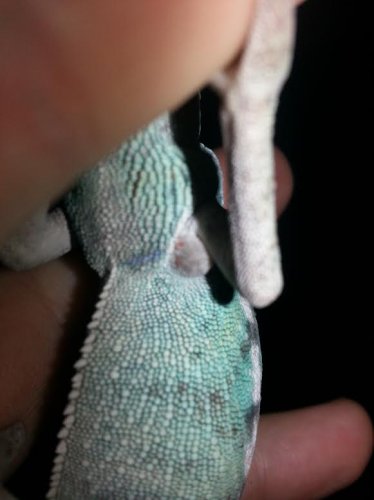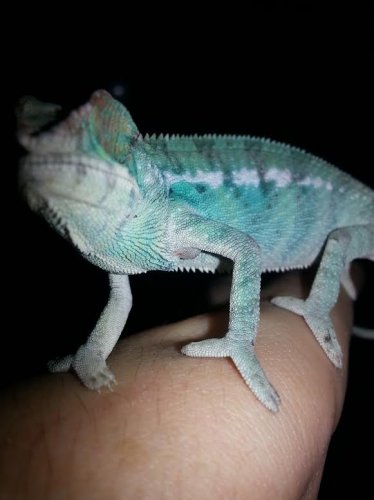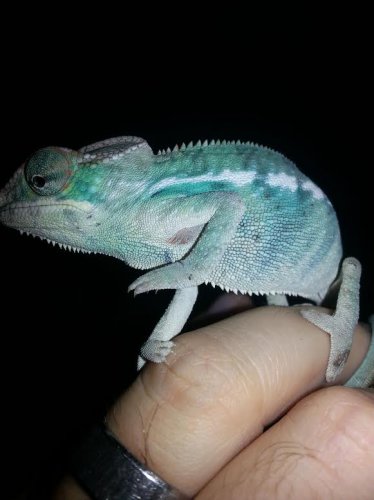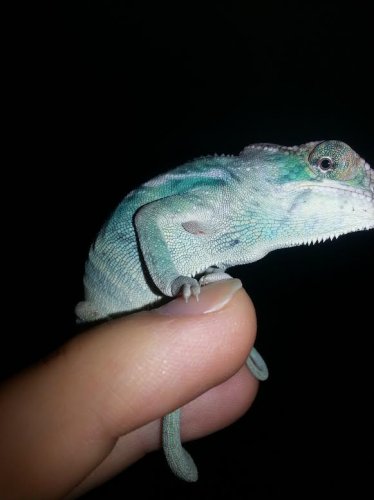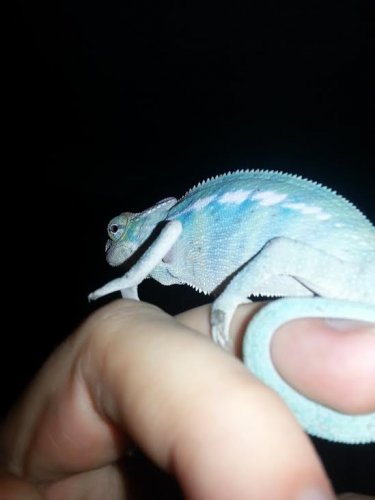Chameleon Info:
Reginald (Reggie), male Nosy Be panther chameleon, hatched between 7/10 and 7/30/2013; received him November 12th.
Handling - I handle him about once a day or once every other day -- more than I plan to in the future to get him accustomed to being handled.
Feeding - Crickets (5-6 small), meal worms (6-7), or dubia roaches (5 small) once per day in the morning. I gutload with Repashy Bug Burger, as recommended by my breeder (he has had tremendous success with this product).
Supplements - Dust food with Repashy Calcium Plus (calcium and vitamin powder) as recommended by breeder.
Watering - Three to four times per day, I mist my chameleon with a high-quality fine mister. I use filtered tap water with Zoo Med's ReptiSafe to remove chlorine and chloramine. Placed order for and waiting to receive "Big Dripper" brand dripper for constant water source (had to order online as no local pet supply stores carry them).
Fecal Description - Normal brown with white urates.
Has this chameleon ever been tested for parasites? No-- received from breeder and took to veterinarian 11/22 to get a base line and establish a file for him for future reference.
History - Healthy, active boy.
Cage Info:
Cage Type - Screen cage 16" x 15" x 29", to be upgraded to an 18" x 24" x 49" screen cage once size necessitates.
Lighting - Zoo Med ReptiSun 5.0 UVB CFL on at 7:30 AM and off at 5:30 PM (10 hour cycle recommended by breeder in winter; 12-hour in summer). 40-Watt incandescent bulb for basking.
Temperature - Room temperature at cage bottom to approx. 92 degrees in basking spot. Lowest overnight temp approximately 70 degrees. Measured with thermometers-- one digital, one analog.
Humidity - Typically averages about 70%, except for during misting times when it is obviously higher. Measured with a digital hygrometer.
Plants - Two fake dangling vines plus a rubber tree with its soil covered completely by river rocks to prevent digging and ingesting.
Placement - Cage located against exterior wall; there is a vent near it (about 52" away and above) but it is not a high-traffic area. The cage is on a piece of furniture that stands about 30" high.
Location - Maryland
Current Problem - I have noticed that Reggie has swollen underarms, similar to a swollen lymph node in a human. There was another post about this issue, but it was about a potentially-gravid female, and all advice seemed to point to this being more normal in females, but not males. I have also contacted my breeder for assistance, but wanted to get multiple opinions. My cham is drinking normally, and he ate as recently as this morning, when I first noticed the lumps. He is very active and seems to be totally healthy otherwise. Any advice is appreciated.





Reginald (Reggie), male Nosy Be panther chameleon, hatched between 7/10 and 7/30/2013; received him November 12th.
Handling - I handle him about once a day or once every other day -- more than I plan to in the future to get him accustomed to being handled.
Feeding - Crickets (5-6 small), meal worms (6-7), or dubia roaches (5 small) once per day in the morning. I gutload with Repashy Bug Burger, as recommended by my breeder (he has had tremendous success with this product).
Supplements - Dust food with Repashy Calcium Plus (calcium and vitamin powder) as recommended by breeder.
Watering - Three to four times per day, I mist my chameleon with a high-quality fine mister. I use filtered tap water with Zoo Med's ReptiSafe to remove chlorine and chloramine. Placed order for and waiting to receive "Big Dripper" brand dripper for constant water source (had to order online as no local pet supply stores carry them).
Fecal Description - Normal brown with white urates.
Has this chameleon ever been tested for parasites? No-- received from breeder and took to veterinarian 11/22 to get a base line and establish a file for him for future reference.
History - Healthy, active boy.
Cage Info:
Cage Type - Screen cage 16" x 15" x 29", to be upgraded to an 18" x 24" x 49" screen cage once size necessitates.
Lighting - Zoo Med ReptiSun 5.0 UVB CFL on at 7:30 AM and off at 5:30 PM (10 hour cycle recommended by breeder in winter; 12-hour in summer). 40-Watt incandescent bulb for basking.
Temperature - Room temperature at cage bottom to approx. 92 degrees in basking spot. Lowest overnight temp approximately 70 degrees. Measured with thermometers-- one digital, one analog.
Humidity - Typically averages about 70%, except for during misting times when it is obviously higher. Measured with a digital hygrometer.
Plants - Two fake dangling vines plus a rubber tree with its soil covered completely by river rocks to prevent digging and ingesting.
Placement - Cage located against exterior wall; there is a vent near it (about 52" away and above) but it is not a high-traffic area. The cage is on a piece of furniture that stands about 30" high.
Location - Maryland
Current Problem - I have noticed that Reggie has swollen underarms, similar to a swollen lymph node in a human. There was another post about this issue, but it was about a potentially-gravid female, and all advice seemed to point to this being more normal in females, but not males. I have also contacted my breeder for assistance, but wanted to get multiple opinions. My cham is drinking normally, and he ate as recently as this morning, when I first noticed the lumps. He is very active and seems to be totally healthy otherwise. Any advice is appreciated.
